|
Making Syrup (2007)
(AT BOTTOM SELECT OTHER YEARS)
Luckily, there is no one proper way to make syrup because whether by design or otherwise, I seem to do it differently from time to time. Of course, beyond that, each syrupmaker has personal preferences based on his or her goals and experiences. As an example, I do not attempt to maximize efficiency or production; I have never sold syrup. I simply want to have fun and make syrup that Nedra will brag on, the latter fortunately being a given.
In 2007, I made two rounds of syrup. That is really more syrup that I need, but my son was visiting on Veterans's Day so I pushed the schedule up a bit for one making and had planned to do a second at my family's tradtional time, Thanksgiving (the second making was 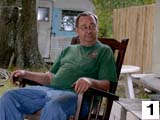 delayed, though). 2007 was terribly terribly droughty, and my production cane was in its fourth and fifth year and had been neglected. So, my season began with a visit to my Nashville syrupmaking friends Gene Luke (Slide 1) and James King (Slide 2), who are neighbors. (Many of you know that Gene did most of the metal fabrications for my syrup operation and James is featured elsewhere on Southern Matters.) Both Gene and James cut back on making syrup this year, but still had large quantities of sugar delayed, though). 2007 was terribly terribly droughty, and my production cane was in its fourth and fifth year and had been neglected. So, my season began with a visit to my Nashville syrupmaking friends Gene Luke (Slide 1) and James King (Slide 2), who are neighbors. (Many of you know that Gene did most of the metal fabrications for my syrup operation and James is featured elsewhere on Southern Matters.) Both Gene and James cut back on making syrup this year, but still had large quantities of sugar 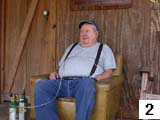 cane. In particular, James had a good bit of Home Green that was not spoken for. Because it is an heirloom (and had a significant historical role in the development of the sugar industry), I arranged to cut a round of it for my first syrup cooking (Nov 11) and primarily used my CP 67-500 for my second cooking (Dec 2). Most of the narrative and all the data are from the first cooking. cane. In particular, James had a good bit of Home Green that was not spoken for. Because it is an heirloom (and had a significant historical role in the development of the sugar industry), I arranged to cut a round of it for my first syrup cooking (Nov 11) and primarily used my CP 67-500 for my second cooking (Dec 2). Most of the narrative and all the data are from the first cooking.
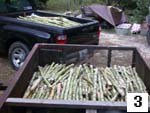 James would have given me all the cane I wanted, but I trie James would have given me all the cane I wanted, but I trie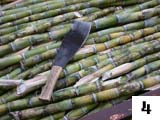 d to get just enough to make a round, but not run out (Slide 3). Though a little on the short side, as Home Green often is, it was beautiful cane (Slide 4). It was d to get just enough to make a round, but not run out (Slide 3). Though a little on the short side, as Home Green often is, it was beautiful cane (Slide 4). It was
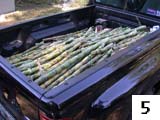 clean and ready to grind. I had overestimated my need and had enough left over to plant (Slide 5). clean and ready to grind. I had overestimated my need and had enough left over to plant (Slide 5).
(For several years, I have tried to grow this comely cane, but without success, and I hope this year is better.)
_red_t.jpg) As mentioned, my second round was with mostly CP 67- As mentioned, my second round was with mostly CP 67-_red_t.jpg) 500, my overall favorite cane. I cut this batch a few days in advance of making syrup, so I trimmed back the ends (Slide 6). My attitude about grinding cane with growth on the ends parallels that of using rotten apples for pies. After trimming the ends off the cane, I washed it, stalk-by-stalk, and stacked it in the trailer (Slide 7) so that it would drain overnight. 500, my overall favorite cane. I cut this batch a few days in advance of making syrup, so I trimmed back the ends (Slide 6). My attitude about grinding cane with growth on the ends parallels that of using rotten apples for pies. After trimming the ends off the cane, I washed it, stalk-by-stalk, and stacked it in the trailer (Slide 7) so that it would drain overnight.
_red_t.jpg)
My estimate of how much would be required to make a round was somewhat improved the second time around and little was left (Slide 8).
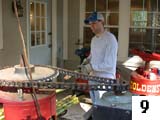
We began grinding at at 0800 and finished at 1100. Sl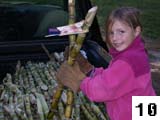 ide 9 shows Will on task . Abigail Garwood, Will's stepdaughter, pitched in and handed Will cane (Slide 10). ide 9 shows Will on task . Abigail Garwood, Will's stepdaughter, pitched in and handed Will cane (Slide 10).
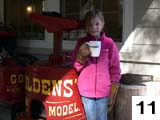
Abby earned the title of "Golden Girl" for reasons that are obvious in Slide 11. (Thanks very much to Dennis Parker for the Golden coffee cup, a favorite.)
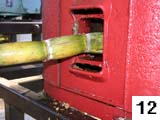 Home Green is a joy to grind (Slide 12)--it yields prodigious amounts of sweet juice and seems made for a one-stalk vertical mill. [The mill shown is a Goldens' No. 2 (New Model) that was manufactured between 1905 (the patent date) and 1924 (when the guide knife design was altered). Indicated by surface pits, it had been on the ground for years before I recovered and restored it.] Home Green is a joy to grind (Slide 12)--it yields prodigious amounts of sweet juice and seems made for a one-stalk vertical mill. [The mill shown is a Goldens' No. 2 (New Model) that was manufactured between 1905 (the patent date) and 1924 (when the guide knife design was altered). Indicated by surface pits, it had been on the ground for years before I recovered and restored it.]
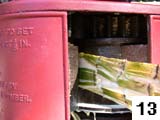
I have my discharge roller set pretty tightly and this 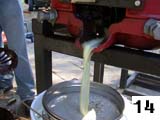 cane comes out of the mill almost cottony (Slide 13). The juice runs through a coarse and then fine SS mesh (Slide 14). cane comes out of the mill almost cottony (Slide 13). The juice runs through a coarse and then fine SS mesh (Slide 14).
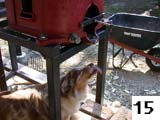 Our way of handling the juice is time consuming and Buttley steps up to Our way of handling the juice is time consuming and Buttley steps up to 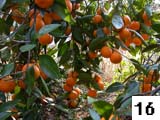 the plate to catch lagging drops of juice that fall while the 5-gallon bucket is being emptied (Slide 15). Of course, her head was a sticky mess by day's end, giving Priss an hours-long "grooming" chore. I cannot, however, criticize Buttley too heavily because I make a run to one of the nearby satsuma trees regularly ( Slide 16). the plate to catch lagging drops of juice that fall while the 5-gallon bucket is being emptied (Slide 15). Of course, her head was a sticky mess by day's end, giving Priss an hours-long "grooming" chore. I cannot, however, criticize Buttley too heavily because I make a run to one of the nearby satsuma trees regularly ( Slide 16).
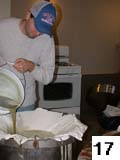 Our goal is to start with the cleanest juice possible, so after Our goal is to start with the cleanest juice possible, so after 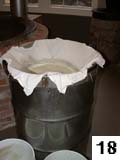 primary filtration, the juice was decanted onto a secondary filter consisting of three layers of diaper into a 50-gallon settling drum (Slide 17, Slide 18). A good measure of time is used in washing the bucket and SS filters after each five gallons and changing out the diaper filters after perhaps ten gallons. . . . but, as mentioned, our efforts are for fun, not profit. primary filtration, the juice was decanted onto a secondary filter consisting of three layers of diaper into a 50-gallon settling drum (Slide 17, Slide 18). A good measure of time is used in washing the bucket and SS filters after each five gallons and changing out the diaper filters after perhaps ten gallons. . . . but, as mentioned, our efforts are for fun, not profit.
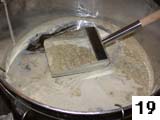 Before transferring the juice to the kettle, I removed Before transferring the juice to the kettle, I removed  surface contaminants as much as possible (Slide 19) and and Will took a Brix measurement (Slide 20). The juice was sweeter than I had expected (18.0) for Home Green, especially since it was fairly early in the season. surface contaminants as much as possible (Slide 19) and and Will took a Brix measurement (Slide 20). The juice was sweeter than I had expected (18.0) for Home Green, especially since it was fairly early in the season.
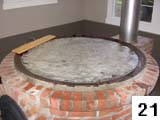 The juice initially was 50 F and The juice initially was 50 F and 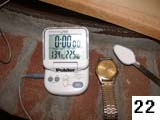 gentle heating began at 1120 (Slide 21). The juice temperature reached 135 F at 1208 when the burner was killed. To prevent "sugaring," I prefer to use invertase (Slide 22, Saccharomyces cerevisiae, 20,000 Sumner units per gram at the rate of 1-1.25 teaspoons per 55 gallons of juice at 135 F for 30 min). (Whether using invertase or acid hydrolysis, it is important to hydrolyze only a minimum of sucrose to minimize darkening and even flavor changes that can come about via the Maillard reaction.) The heat in the furnace continued to heat the juice, up to 138 F, and the burner was re-ignited at 1238. In order to denature invertase, I aim to heat the juice to, say, 180 F as quickly as convenient. gentle heating began at 1120 (Slide 21). The juice temperature reached 135 F at 1208 when the burner was killed. To prevent "sugaring," I prefer to use invertase (Slide 22, Saccharomyces cerevisiae, 20,000 Sumner units per gram at the rate of 1-1.25 teaspoons per 55 gallons of juice at 135 F for 30 min). (Whether using invertase or acid hydrolysis, it is important to hydrolyze only a minimum of sucrose to minimize darkening and even flavor changes that can come about via the Maillard reaction.) The heat in the furnace continued to heat the juice, up to 138 F, and the burner was re-ignited at 1238. In order to denature invertase, I aim to heat the juice to, say, 180 F as quickly as convenient.
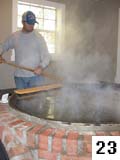
We spent about an hour skimming, longer than most do (Slide 23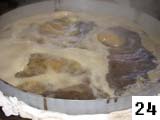 ). During this period, we kept the juice just below boiling. We poured the heat to it at 1335 (Slide 24) ). During this period, we kept the juice just below boiling. We poured the heat to it at 1335 (Slide 24)
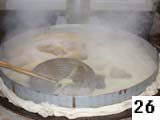 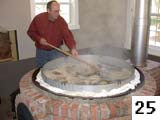
and continued skimming (Slide 25), soon using the skimmer to rake skimmings over the ring (Slide 26).
The frothing climbed up on the ring quicky (Slide 27.) By1352--less than 20 minutes from pouring the heat to the kettle--the juice was self-skimming (Slide 28).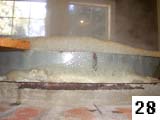 The flue temp The flue temp_red_t.jpg) erature was at the high end of normal (890 F) and though we choked the furnace, the temperature continued to rise to 950 F. (There's no fire hazard since my flue is rated at 1400 F continuous and 1800 F intermittant, but I expect that lower temperatures would be more efficient.) erature was at the high end of normal (890 F) and though we choked the furnace, the temperature continued to rise to 950 F. (There's no fire hazard since my flue is rated at 1400 F continuous and 1800 F intermittant, but I expect that lower temperatures would be more efficient.)
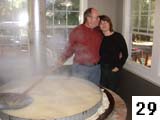 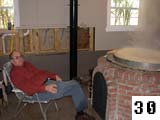
1400 found me in a sportive mood, searching for whatever is sweet and available <grin>. I was caught by the camera (Slide 29), before I settled down (Slide 30).
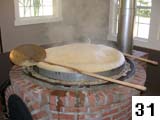 I monitor the nascent syrup temperature and generally do not take density measurements until the temperature gets in the 223 F range. I jumped the gun a little this day, though, and took a Baume reading at 1435 (=9) and 1450 (= 11) when Slide 31 was taken. At 1530, the Baume reading had increased to 17; by 1550, to 22. I monitor the nascent syrup temperature and generally do not take density measurements until the temperature gets in the 223 F range. I jumped the gun a little this day, though, and took a Baume reading at 1435 (=9) and 1450 (= 11) when Slide 31 was taken. At 1530, the Baume reading had increased to 17; by 1550, to 22.
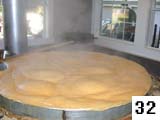 At 1600, the syrup was coming into its own (Slide 32 At 1600, the syrup was coming into its own (Slide 32_red_t.jpg) ); it had darkened and the boiling formed "hog eyes," similar to the way grits boil. . . . too bad that you can't smell it from your computer <sad>. In a side view (2d grinding), the undulating boiling surface is more apparent (Slide 33). ); it had darkened and the boiling formed "hog eyes," similar to the way grits boil. . . . too bad that you can't smell it from your computer <sad>. In a side view (2d grinding), the undulating boiling surface is more apparent (Slide 33).
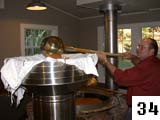 At 1611, the density had increased to 28; at 1620, to 31; at 1625, to 32; at 1638, to 35, when we took the syrup off (Slide 34). This is the most tense period since the syrup needs to be removed as rapidly as possible to avoid further density changes and excessive caramelization on the kettle walls. I filtered through one layer of flannel into a SS funnel that feeds into a SS tank that, in turn, is mounted on a cart, which can be rolled up to the kettle. At 1611, the density had increased to 28; at 1620, to 31; at 1625, to 32; at 1638, to 35, when we took the syrup off (Slide 34). This is the most tense period since the syrup needs to be removed as rapidly as possible to avoid further density changes and excessive caramelization on the kettle walls. I filtered through one layer of flannel into a SS funnel that feeds into a SS tank that, in turn, is mounted on a cart, which can be rolled up to the kettle.
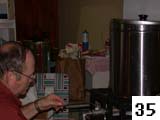 The yield was 71 12.7-oz bottles (from 55 gallons of juice) The yield was 71 12.7-oz bottles (from 55 gallons of juice)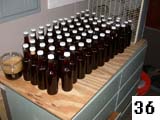 and bottling time averaged 3 min/case (end temperature = 179 F). After tightening a cap, the bottle was inverted into a box. After filling the box, it was held for 10 min; then, the box was turned upside down and held for another 10 min. Finally, the bottles were removed from the box and spaced under a fan to cool as quickly as possible (Slide 36). and bottling time averaged 3 min/case (end temperature = 179 F). After tightening a cap, the bottle was inverted into a box. After filling the box, it was held for 10 min; then, the box was turned upside down and held for another 10 min. Finally, the bottles were removed from the box and spaced under a fan to cool as quickly as possible (Slide 36).
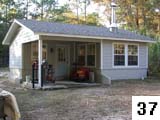
Clean-up has its place, too. At the end of the day, the syrup house was tranquil, seeming to be unaware of the fun it had housed (Slide 37).
SELECT OTHER YEARS OF SYRUPMAKING FROM TABLE BELOW


|